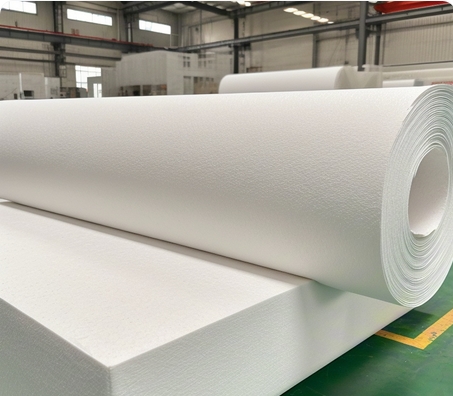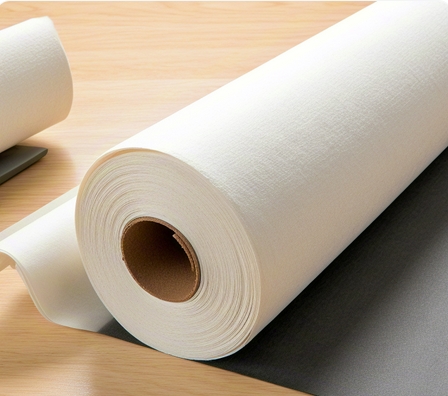Language

In the field of contemporary high-end manufacturing, clean room masks have broken through the positioning of basic protective equipment and upgraded to the core regulatory component of the precision production environment. This type of professional protective equipment is deeply integrated into strategic industries such as semiconductor etching, genetic engineering, and microelectronic packaging. With its 0.1-10 micron-level particle interception capability, it protects the world's advanced manufacturing cluster with an output value of over one trillion US dollars.
Taking the KA10 series ear-mounted dust-free masks as an example, its technical iteration path perfectly interprets the coordinated evolution law of industrial upgrading and protection needs. [Semiconductor Manufacturing: Precision Defense Line for Microscopic Pollution] In a 3nm process wafer production environment (compliant with ISO Class 1 clean standards), the number of particles ≥0.1μm in each cubic meter of air must be strictly controlled within 10.
At this time, the water vapor condensation nucleus (diameter about 0.3μm) generated by the operator's breathing can lead to defects in the lithography process. Therefore, the mask needs to meet the triple technical specifications: first, the electrostatic control capability, the surface resistance must be stable in the 10^6-9Ω range (compliant with the ESD S20.20 standard), to prevent the electrostatic charge from damaging the nanoscale circuit; secondly, FEP fluorinated film layer material is used, and the total organic volatile release amount is strictly limited to below 0.8μg/g (compliant with the SEMI F72 specification); finally, the fully plasticized structural design is implemented to completely eliminate the risk of heavy metal pollution. The actual data from TSMC's 12-inch wafer fab shows that when using dust-free masks that meet SEMI E78-1102 standards, the concentration of AMC pollutants is reduced by 71.8%, and the wafer yield rate is increased by 1.83 percentage points.
[Biopharmaceuticals: Biochemical barrier for bidirectional protection] In the sterile injection filling line (ISO level 5 environment), a dual protection system is required forclean room masks: 99.992% retention rate of ≥0.3μm particles (EN 14387 P3 certification), and 99.999% microbial blockade efficiency (ASTM F2101 standard) is achieved internally. The internationally leading BioShield Pro series adopts an innovative composite architecture: the outer layer is a super hydrophobic spun bond (contact angle up to 125°), which can effectively block culture medium splash; the intermediate layer fuses electret melt blown material and a 0.52% concentration silver ion coating to maximize the efficiency of microbial inactivation; the inner layer is equipped with a 50nm pore nanofiber membrane to successfully intercept aerosols of pathogens such as coronavirus.
The application case of the Pfizer vaccine production base shows that the design reduces the microbial contamination incidents in the filling line by 89%, and the product scrap rate is reduced to 0.0007%.
In the field of biopharmaceuticals, clean room masks are used as key protective equipment to significantly improve the cleanliness of the production environment. After the monoclonal antibody workshop of an international pharmaceutical company used a three-layer composite structural mask, environmental monitoring data showed that the level of microbial pollution dropped from 0.8 CFU/m³ to 0.1 CFU/m³ (compliant with FDA 21 CFR 211.42 standards), which is equivalent to increasing the cleanliness of the production environment to an operating room level of 8 times.
This specially designed mask shows excellent performance in the optical precision manufacturing process: in the Class 100-level high-energy laser lens coating workshop, the fiber shedding per minute per square centimeter (meets the IEST-RP-CC007. 3 specification), and combined with the composite technology of fused quartz fiber and polyimide, the surface scattered particle density of the material is less than 5 pieces/cm² (MIL-STD-1246C). A national laboratory report shows that such mirror-grade masks have made the laser damage threshold of optical components exceed the 25J/cm² mark, successfully extending the service life of the optical components of the inertial constrained fusion device to 4,000 pulse cycles. The food industry has put forward unique requirements for clean room masks, especially in the sterile filling process of infant formula milk.
Masks that meet GMP Class A standards must pass EC 1935/2004 food contact material certification, and their surface migration must be less than 0.01mg/dm². After 30 minutes of steam sterilization of innovative cellulose monocrystals (CNC) enhanced masks at 121°C, the filtration efficiency attenuation rate was only 0.8%, and the filtration efficiency was maintained at 99.97% even in a 90% RH high humidity environment.
After a dairy giant implemented this technology, the total amount of waste in the packaging workshop decreased by 58%, while the incidence of microbial contamination incidents decreased by 72%. Emerging technology fields pose more stringent challenges to the performance of masks.
The operating environment of the dilution refrigerator in the quantum computing laboratory requires the mask to remain flexible at low temperatures of -273℃. The leakage rate of the new PVA water-soluble fiber mask at extremely low temperatures is only 1.18 times that of the normal temperature environment. In the field of gene therapy, the graphene/MOF composite filter material used in the viral vector production workshop has an efficiency of 4.2log on 20-300nm virus particles, which is equivalent to intercepting 99.994% of virus particles per cubic centimeter.
The latest test data of the International Space Station shows that magnetron sputtered coating masks achieve 99.9993% filtration efficiency in microgravity environments, providing a reliable protective barrier for space manufacturing.
The cost-effectiveness study of cross-industry protective equipment reveals significant technological investment differences (see data comparison for details): In the field of semiconductor manufacturing, the unit price of clean room masks is US$120-300 and forced replacement every 4 hours, but it accounts for only 0.03% of the production line operating costs, which is equivalent to only matching the protection budget of US$300 per million USD. In contrast, the biopharmaceutical industry adopts US$25-80 medical clean room masks. Although the daily use time is extended to 8 hours, the proportion of protective expenditure is still 0.12%. The most eye-catching thing is the food processing industry, whose basic protective masks of $1.5-5 are economical, but have an annual safety cost of 0.35% due to frequent replacements.
This value paradox stems from the differences in protection requirements hierarchy: microelectronic manufacturing requires submicron-level particle barrier capability, and its clean room mask adopts a 12-layer gradient filter structure, which can intercept 99.999% of 0.1μm particles; while the biological clean room focuses on preventing microbial aerosols, it is necessary to integrate electrostatic electret melt blown cloth and silver ion antibacterial layer. It is worth noting that the latest disclosure by ASML lithography machine manufacturer has revealed that its clean room operation specifications have listed intelligent respiratory impedance adjustment masks asstandard configurations, through pressure.
Tags:
RELATED RESOURCES

Industrial Clean room Paper Performance Standards and Scenario Adaptation Manual.
As a key material for modern industrial cleaning, dust-free paper has a composite structure made of refined wo......
More

From clean room to operating room: 7 application forbidden areas where dust-free cloth and non-woven
In the fields of industry and people's livelihood, although dust-free cloth and non-woven fabric are simil......
More

Application of reel dust-free cloth in display panel manufacturing: 0.5mm precision cleaning solutio
In the fields of advanced manufacturing and microelectronics, submicron pollution control is directly related ......
More

How to meet the Class 1000 standard for dust-free cloth? Material engineering and spray pressure con
1.Performance benchmark of clean room core consumables The dust-free cloth standard refers to the technical sp......
More
Related Products
Room 101, Building 1, Angeer Factory, No.4, Hetian Road, Shatian Community, Kengzi Street, Pingshan District, Shenzhen, Guangdong, P.R. China 518122
info@wipestar.com
+86-755-89616775
+86-755-89616773
Related Products
RELATED RESOURCES

Industrial Clean room Paper Performance Standards and Scenario Adaptation Manual.
As a key material for modern industrial cleaning, dust-free paper has a composite structure made of refined wo.........
More

From clean room to operating room: 7 application forbidden areas where dust-free cloth and non-woven
In the fields of industry and people's livelihood, although dust-free cloth and non-woven fabric are simil.........
More
WIPESTAR
微信官方公众号